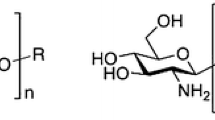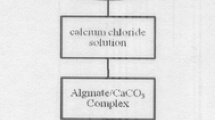Abstract
Studies on the extraction behavior and immobilization of cadmium by greener reagents have important bearings in today’s science. No-carrier-added (NCA), 109Cd radionuclide is a potential candidate towards radiopharmaceutical studies for both in vivo and in vitro applications and is also used in industrial and environmental studies. Herein, we have studied the adsorption and desorption characteristics of cadmium in both NCA and bulk concentrations into calcium alginate using radiochemical method. Various isotherms like Langmuir, Freundlich, Temkin and Dubinin–Radushkevich have been studied and compared to match the adsorption phenomenon. A spontaneous endothermic physisorption process is expected from thermodynamic parameters.











Similar content being viewed by others
References
Vis RD, Bos AJJ, Idzenga S, Verheul H (1979) Perturbed γ-γ angular correlations of 111mCd bound on DNA. Nucl Inst Meth 163:265–267
Das SK, Guin R, Banerjee D, Johnston K, Das P, Butz T, Amaral VS, Correia JG, Barbosa MB (2014) Perturbed angular correlation study of the static and dynamic aspects of cadmium and mercury atoms inside and attached to a C60 fullerene cage. Z Naturforsch A 69:611–618
Goetz L, Sabbioni E, Marafante E, Birattari C, Bonardi M (1980) Cyclotron production of 107,109Cd for use in metallobiochemistry of heavy metal pollution. Radiochem Radioanal Lett 45:51
Lahiri S, Mukhopadhyay B, Nandy M, Das NR (1997) Sequential separation by HDEHP of carrier-free 101,105,106Rh, 103,104,105,106,110,112Ag and 104,105,107,109,111Cd produced in alpha particle activated palladium. J Radioanal Nucl Chem 224:155–158
Long X, Peng X, Fuqing H, Mantian L (1991) Production of cadmium-107 and cadmium-109 by deuteron bombardment of silver. Int J Appl Radiat Isot 42:1234–1236
Peng X, Xianguan L, He F, Li M (1992) Excitation function for 107Ag(d,2n)107Cd, 109Ag(d,2n)109Cd and 109Ag(d, p)110mAg reactions. Nucl Instrum Meth B 68:145–148
Aardaneh K, Naidoo C, Steyn GF (2008) Radiochemical separation of 109Cd from a silver target, J Radioanal. Nucl Chem 276:831–834
Xue Z, Rehkämper M, Schönbächler M, Statham PJ, Coles BJ (2012) A new methodology for precise cadmium isotope analyses of seawater. Anal Bioanal Chem 402:883–893
Zhu C, Wen H, Zhang Y, Fu S, Fan H, Cloquet C (2016) Cadmium isotope fractionation in the Fule Mississippi Valley-type deposit, Southwest China. Miner Depos. doi:10.1007/s00126-016-0691-7
Krishnamurthy N (2013) Engg. chemistry, 2nd edn. PHI Learning Private Limited, New York, pp 82–83. ISBN 978-81-203-3666-7
Marder L, Bernardes AM, Ferreira JZ (2004) Cadmium electroplating wastewater treatment using a laboratory-scale electrodialysis system. Sep Purif Technol 37:247–255
Scoullos Michael J, Vonkeman Gerrit H, Iain Thornton, Zen Makuch (2001) Mercury, cadmium, lead. Handbook for sustainable heavy metals policy and regulation. Springer, New York. ISBN 978-1-4020-0224-3
Bezerraa MA, Maêdaa SMN, Oliveiraa EP, Carvalhoc MD, Santellia RE (2007) Internal standardization for the determination of cadmium, cobalt, chromium and manganese in saline produced water from petroleum industry by inductively coupled plasma optical emission spectrometry after cloud point extraction, Spect. Acta Part B: At Spectrosc 62:985–991
Adeniyi AA, Afolabi JA (2002) Determination of total petroleum hydrocarbons and heavy metals in soils within the vicinity of facilities handling refined petroleum products in Lagos metropolis. Environ Int 28:79–82
Bernard A (2008) Cadmium & its adverse effects on human health. Indian J Med Res 128:557–564
Agency for Toxic Substances and Disease Registry (ATSDR) (1997) Toxicological profile for cadmium. Draft for public comment. Public Health Service, US Department of Health and Human Services, Atlanta
Calabrese EJ, Kenyon EM (1991) Air toxics and risk assessment. Lewis Publishers, Chelsea
US Department of Health and Human Services. Hazardous Substances Data Bank (HSDB, online database). (1993) National toxicology information program, National Library of Medicine, Bethesda
Maiti M, Ghosh K, Lahiri S (2015) Green methods for the radiochemical separations of no-carrier added 61Cu, 62Zn from 7Li irradiated cobalt target. J Radioanal Nucl Chem 303:2033–2040
Fuks L, Oszczak A, Gniazdowska E, Sternik D (2015) Calcium alginate and chitosan as potential sorbents for strontium radionuclide. J Radioanal Nucl Chem 304:15–20
Fadl FIAE (2014) Radiation grafting of ionically crosslinked alginate/chitosan beads with acrylic acid for lead sorption. J Radioanal Nucl Chem 301:529–535
Yagnesh L, Patel PS, Atmaram PP (2006) The effect of drug concentration and curing time on processing and properties of calcium alginate beads containing metronidazole by response surface methodology. AAPS PharmSciTech 7(4):E1–E7
Maiti M, Lahiri S, Tomar BS (2011) Separation of no-carrier-added 107,109Cd from proton induced silver target: classical chemistry still relevant. J Radioanal Nucl Chem 288:115–119
Ghosh K, Maiti M, Lahiri S, Afzal Hussain (2014) Ionic liquid-salt based aqueous biphasic system for separation of 109Cd from silver target. J Radioanal Nucl Chem 302:925–930
Maiti M, Ghosh K, Lahiri S (2013) Simultaneous production and separation of no-carrier-added 111In, 109Cd from alpha particle induced silver target. J Radioanal Nucl Chem 295:1945–1950
Sarkar K, Ansari Z, Sen K (2016) Detoxification of Hg(II) from aqueous and enzyme media: pristine vs. tailored calcium alginate hydrogels. Int J Biol Macromol 91:165–173
Sarkar K, Sen K (2015) On the design of Ag-morinnanocomposite to modify calcium alginate gel: framing out a novel sodium ion trap. RSC Adv. 5:57223–57230
Mondal A, Lahiri S (2011) Separation of 134Cs and 133Ba radionuclides by calcium alginate beads. J Radioanal Nucl Chem 290:115–118
Sharma YC, Srivastava V, Upadhyay SN, Weng CH (2008) Alumina nanoparticles for the removal of Ni(II) from aqueous solutions. Ind Eng Chem Res 47:8095–8100
Vermeulan TH, Vermeulan KR, Hall LC (1966) Fundamental. Ind Eng Chem 5:212–223
Dada AO, Olalekan AP, Olatunya A, Dada O (2012) Langmuir, Freundlich, Temkin and Dubinin–Radushkevich isotherms studies of equilibrium sorption of Zn2+ unto phosphoric acid modified rice husk. IOSR-JAC 3:38–45
Hutson ND, Yang RT (2000) Adsorption. J Colloid Interf Sci p 189
Mohan S, Karthikeyan J (1997) Removal of lignin and tannin color from aqueous solution by adsorption on to activated carbon solution by adsorption on to activated charcoal. Environ Pollut 97:183–187
Goldberg S (2005) “Equations and models describing adsorption processes in soils”. Soil Science Society of America, 677 S. Segoe Road, Madison, WI 53711, USA. Chemical processes in soils. SSSA book series, no. 8
Temkin MJ, Pyzhev V (1940) Recent modifications to Langmuir isotherms. Acta Phys chim. URSS 12:217–225
Khan TA, Chaudhry SA, Ali I (2015) Equilibrium uptake, isotherm and kinetic studies of Cd(II) adsorption onto iron oxide activated red mud from aqueous solution. J Mol Liq 202:165–175
Hutson ND, Yang RT (1997) Theoretical basis for the Dubinin–Radushkevitch (D–R) adsorption isotherm equation. Adsorption 3:189–195
Dawodu FA, Akpomie GK, Ogbu IC (2012) Isotherm modeling on the equilibrium sorption of cadmium(II) from solution by Agbani clay. Int. J. Multidiscp. Sc. Eng. 3:9–14
Villanueva RAC, Vázquez ARH, de Jesús Cortés Penagos C, Martínez RC (2014) Thermodynamic, kinetic, and equilibrium parameters for the removal of lead and cadmium from aqueous solutions with calcium alginate beads. Sci World J. doi:10.1155/2014/647512
Bayramoglu G, Arica MY (2011) Preparation of a composite biosorbent using Scenedesmusquadricauda biomass and alginate/polyvinyl alcohol for removal of Cu(II) and Cd(II) ions: isotherms kinetics, and thermodynamic studies. Water Air Soil Pollut 221:391–403
Verweij W (2005) ‘CHEAQS PRO’: a program for calculating chemical equilibria in aquatic systems’. http://home.tiscali.nl/cheaqs/. Accessed 25 Oct 2016
Wanga F, Lua X, Lia XY (2016) Selective removals of heavy metals (Pb2+, Cu2+, and Cd2+) from waste water by gelation with alginate for effective metal recovery. J Hazard Mater 308:75–83
Vijayaraghavan K, Jegan JR, Palanivelu K, Velan M (2005) Nickel recovery from aqueous solution using crab shell particles”. Adsorpt Sci Technol 23:303–311
Kadirvelu K, Namasivayan C (2003) Utilization of various agricultural waste for activated carbon preparation and application for the removal of dyes and metal ions from aqueous. Bioresour Technol 87:129–132
Chowdhury ZZ, Zain SM, Khan RA, Khalid K (2011) Linear regression analysis for kinetics and isotherm studies of sorption of manganese(II) ions onto activated palm ash from waste water. Orient J Chem 27:405–415
Bayramoglu G, Arica MY (2009) Construction a hybrid biosorbent using Scenedesmus quadricauda and Ca alginate for biosorption of Cu(II), Zn(II) and Ni(II): kinetics and equilibrium studies. Bioresour Technol 100:186–193
Zhang F, Jin Q, Chan SW (2004) Ceria nanoparticles: size, size distribution, and shape. J Appl Phys 95:4319–4325
Papageorgiou SK, Kouvelos EP, Katsaros FK (2008) Calcium alginate beads from Laminariadigitata for the removal of Cu+2 and Cd+2 from dilute aqueous metal solutions. Desalination 224:293–306
Niţã I, Iorgulescu M, Spiroiu MF, Ghiurea M, Petcu C, Cintezã O (2007) The adsorption of heavy metal ions on porous calcium alginate microparticles. Analele Universităţii din Bucuresti—Chimie, Anul XVI (serienouă) 1:59–67
Bayramoğlu G, Tuzun I, Celik G, Yilmaz M, Arica MY (2006) Biosorption of mercury(II), cadmium(II) and lead(II) ions from aqueous system by microalgae Chlamydomonasreinhardtii immobilized in alginate beads. Int J Miner Process 81:35–43
Ozdemir G, Ceyhan N, Manav E (2005) Utilization of an exopolysaccharide produced by Chryseomonasluteola TEM05 in alginate beads for adsorption of cadmium and cobalt ions. Bioresour Technol 96:1677–1682
Cataldo S, Cavallaro G, Gianguzza A, Lazzara G, Pettignano A, Piazzese D, Villaescusa I (2013) Kinetic and equilibrium study for cadmium and copper removal from aqueous solutions by sorption onto mixed alginate/pectin gel beads. J Environ Chem Eng 1:1252–1260
Jain M, Garg VK, Kadirvelu K (2013) Cadmium(II) sorption and desorption in a fixed bed column using sunflower waste carbon calcium–alginate beads. Bioresour Technol 129:242–248
Basso MC, Cerrella EG, Cukierman AL (2002) Activated carbons developed from a rapidly renewable biosource for removal of cadmium(II) and nickel(II) ions from dilute aqueous solutions. Ind Eng Chem Res 41:180–189
Debnath S, Nandi D, Ghosh UC (2011) Adsorption–desorption behavior of cadmium(II) and copper(II) on the surface of nanoparticle agglomerates of hydrous titanium(IV) oxide. J Chem Eng Data 56:3021–3028
Luo X, Guo B, Wang L, Deng F, Qi R, Luo S, Au C (2014) Synthesis of magnetic ion imprinted fluorescent CdTe quantum dots by chemical etching and their visualization application for selective removal of Cd(II) from water. Colloids Surf A 462:186–193
Repo E, Warchol JK, Bhatnagar A, Sillanpa M (2011) Heavy metals adsorption by novel EDTA-modified chitosan–silica hybrid materials. J Colloid Interface Sci 358:261–267
Khan TA, Singh VV, Ali I (2009) Sorption of Cd(II), Pb(II) and Cr(VI) metal ions from wastewater using bottom fly ash as a low cost sorbent. J Environ Prot Sci 3:124–132
Khan TA, Singh VV (2010) Removal of cadmium(II), lead(II), and Chromium(VI) ions from aqueous solution using clay. Toxicol Environ Chem 92:1435–1446
Acknowledgement
One of the authors gratefully acknowledges the University Grants Commission (UGC) for providing necessary fellowship. This work is a part of SINP-DAE 12 Five years plan project Trace and Ultratrace Analysis and Isotope Production (TULIP).
Author information
Authors and Affiliations
Corresponding author
Rights and permissions
About this article
Cite this article
Sarkar, K., Sen, K. & Lahiri, S. Radiometric analysis of isotherms and thermodynamic parameters for cadmium(II) adsorption from aqueous medium by calcium alginate beads. J Radioanal Nucl Chem 312, 343–354 (2017). https://doi.org/10.1007/s10967-017-5213-2
Received:
Published:
Issue Date:
DOI: https://doi.org/10.1007/s10967-017-5213-2




